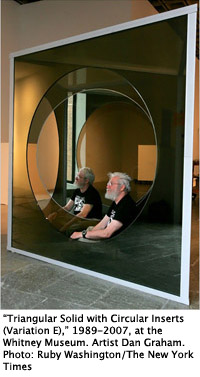A Round Peg
by Randy Kennedy
The New York Times
June 25, 2009
 Here’s a good art-world quiz question, one that could stump many an astute insider: What do Sol LeWitt, Sonic Youth, Dean Martin, Mel Brooks, Merle Haggard, Hudson River School painting and midcentury New Jersey tract housing have in common?
Here’s a good art-world quiz question, one that could stump many an astute insider: What do Sol LeWitt, Sonic Youth, Dean Martin, Mel Brooks, Merle Haggard, Hudson River School painting and midcentury New Jersey tract housing have in common?
The answer, Dan Graham “” a Zelig of so many creative circles over the past four decades it is dizzying to keep track “” sat recently sipping an iced tea and eavesdropping on conversations at the Whitney Museum of American Art, where a retrospective of his work opened Thursday, finally adding him to the ranks of conceptual art”™s thorny 1960s pioneers to receive a full-blown American career survey. (The show, organized with the Los Angeles Museum of Contemporary Art, began there and travels to the Walker Art Center in Minneapolis after it closes in New York on Oct. 11.)
Among his conceptual peers, those who set out to wrest art from the realm of objects and move it more fully into one of ideas, Mr. Graham, 67, is someone whose work does not come easily to mind even for an informed artgoing public. In part this is because his restless intellect has never allowed him to settle into anything resembling a signature style or to be easily categorized. (Most attempts at categorization are parried by Mr. Graham himself with a professorial annoyance and fencer”™s agility, and he dislikes being called a conceptual artist and says he is not a professional one in any sense, calling art his “passionate hobby.”)
If the world had nothing else for which to thank him, it might be enough that during a brief stint as a dealer he gave LeWitt his first solo gallery show, along with presenting early work by Dan Flavin and Donald Judd. Or for the part Mr. Graham played later in the formation of Sonic Youth “” he helped Kim Gordon, one of the group”™s founders, land her first New York apartment in his Lower East Side building and cast her in an all-girl “band” for a 1980s performance piece, jump-starting her music career. When Mr. Graham, rumpled and white-bearded with a kind of Mr. Natural aura, shows up at cutting-edge rock concerts these days, well-read 20-somethings tend to mill around him admiringly.
But it is the way his artistic DNA has seeped into the work of younger artists over such a prolonged period that underscores his importance. Chrissie Iles, a curator at the Whitney who organized the show with Bennett Simpson, a curator at the Los Angeles Museum of Contemporary Art, said that prominent artists as well distributed over the years as Tony Oursler (video artist, born 1957), Rirkrit Tiravanija (known for the shows in which he cooks for gallery visitors, born 1961) and Wade Guyton (who “paints” with printers, born 1972) all showed strong traces of Mr. Graham”™s influence. Their work looks and feels almost nothing like his, or like one another”™s, a remarkable testament to the way Mr. Graham”™s fascination with perception and with the conventions of art and mass-produced culture have become part of the contemporary art landscape.
Because so much of his work “” from early pop-culture writing to performances with video cameras to his well known mirrored pavilions “” is about what Mr. Simpson called “the way one experiences the space of the self,” it has also seemed more prescient as each new iteration of the Web alters the calculus of media, society and individuality.
Read the rest of this article here.
